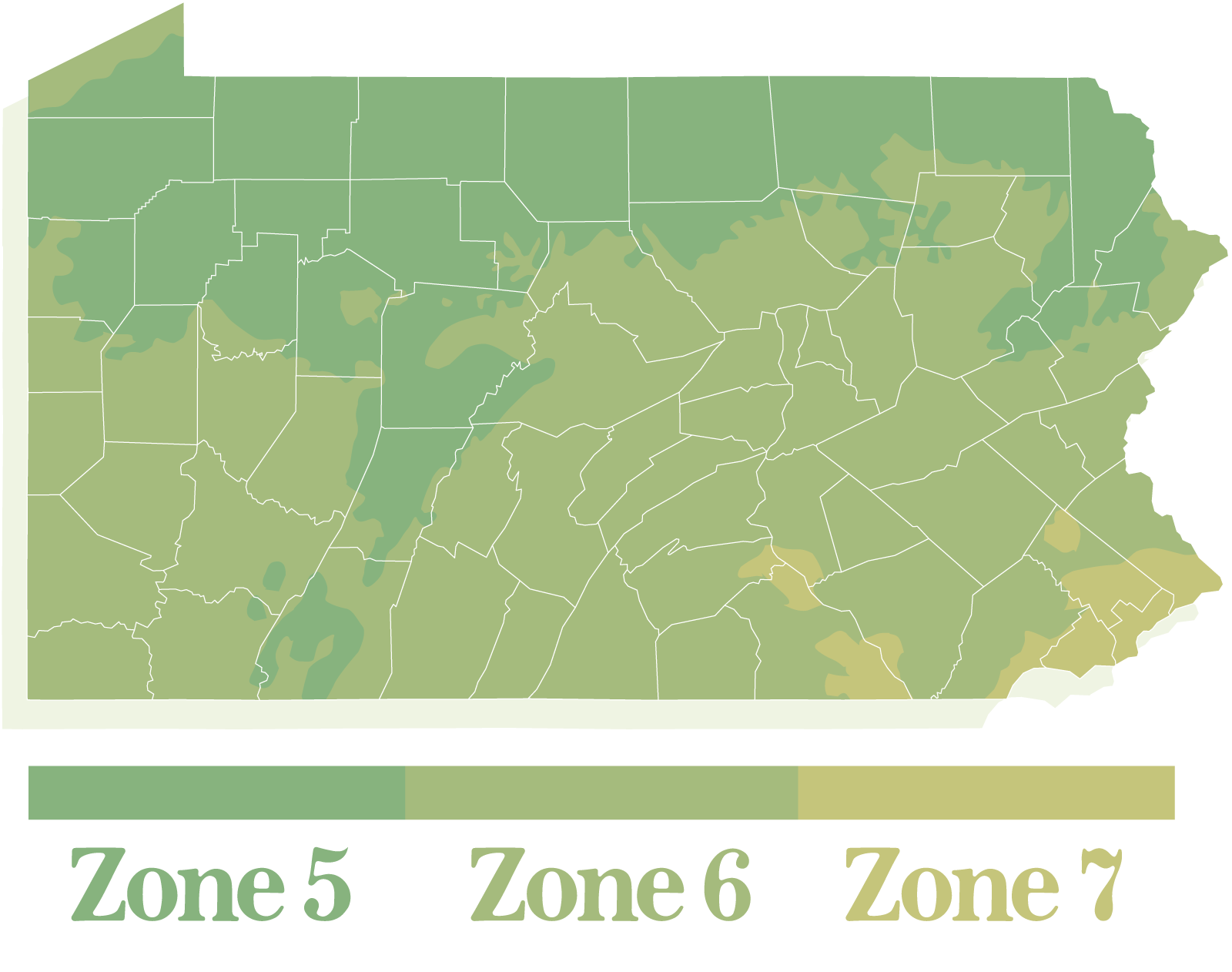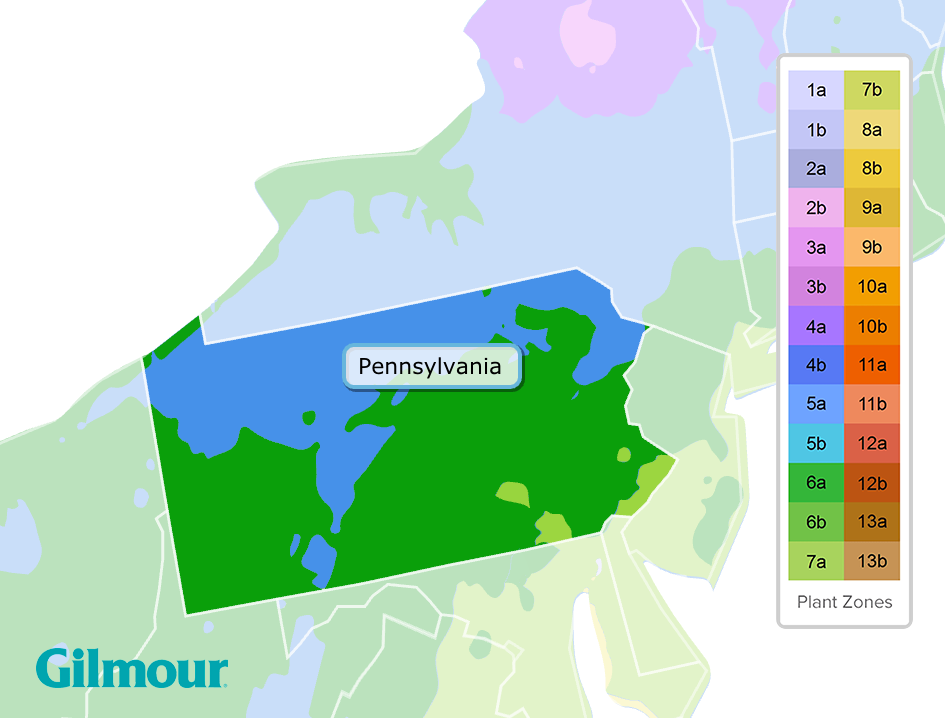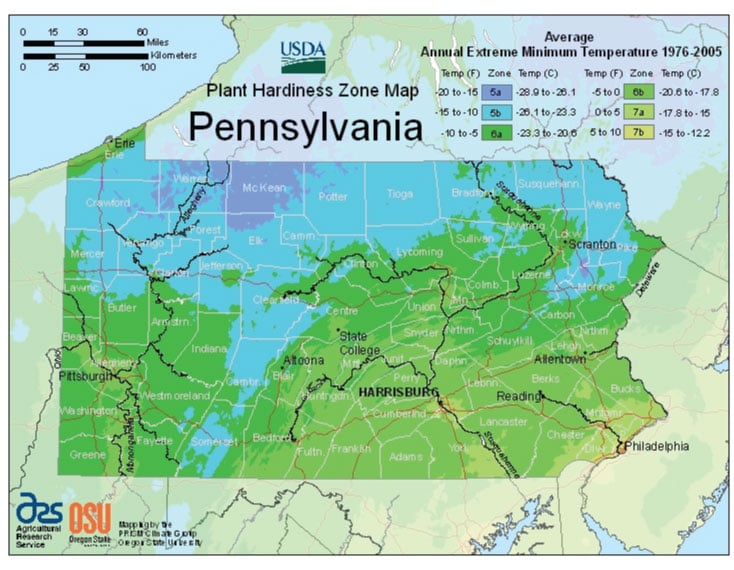Ever found yourself wondering, “What zone is Pennsylvania in for gardening?” If you’re eager to transform your garden into a vibrant oasis, understanding your planting zone is key.
This knowledge can be the difference between flourishing flowers and withering woes. You might be surprised at how much power this little piece of information holds. Imagine saving time, energy, and money by choosing the right plants that are perfectly suited for your region’s climate.
Discovering your gardening zone will unlock secrets to a lush, thriving garden, and we’re here to guide you every step of the way. Ready to dig in? Let’s explore Pennsylvania’s gardening zone and how it can make all the difference for your green thumb aspirations.

Credit: www.visitpa.com
JUMP TO TOPIC
Pennsylvania Gardening Zones
Pennsylvania boasts diverse climates and landscapes, making it ideal for gardening. Understanding gardening zones helps you choose suitable plants for your garden. These zones guide you on when to plant and harvest.
Pennsylvania falls into several gardening zones. The U.S. Department of Agriculture divides regions based on average winter temperatures. Zones range from 5a to 7b in Pennsylvania.
Zone 5a
Zone 5a covers the northern areas of Pennsylvania. Winter temperatures drop between -15 to -20 degrees Fahrenheit. Hardy plants thrive here, tolerating cold snaps.
Zone 5b
Zone 5b offers slightly milder winters. Temperatures range from -10 to -15 degrees Fahrenheit. This zone is suitable for cold-resistant flowers and vegetables.
Zone 6a
Zone 6a spans central and western Pennsylvania. Winter temperatures range from -5 to -10 degrees Fahrenheit. Growers can cultivate a broader range of plants here.
Zone 6b
Zone 6b sees winter temperatures between 0 and -5 degrees Fahrenheit. This zone covers parts of south-central Pennsylvania. It allows for more diverse gardening options.
Zone 7a
Zone 7a includes southeastern Pennsylvania. Winter temperatures range from 0 to 5 degrees Fahrenheit. Growers can plant a wider variety of flowers and crops.
Zone 7b
Zone 7b experiences the mildest winters in Pennsylvania. Temperatures range from 5 to 10 degrees Fahrenheit. This zone supports an extensive selection of plants.
Understanding your zone helps you plan a successful garden. Planting the right species ensures vibrant growth and yields.

Credit: gilmour.com
Understanding Usda Hardiness Zones
Pennsylvania’s gardening zones range from 5a to 7b on the USDA Hardiness Scale. This variation offers diverse planting options. Knowing your specific zone helps choose the right plants.
Understanding USDA Hardiness Zones is crucial for any gardener, whether you’re a novice or an experienced green thumb. These zones give you insights into what plants will thrive in your area based on climate conditions. For those of you gardening in Pennsylvania, knowing your USDA Hardiness Zone can make a significant difference in the success of your garden. ###What Are Usda Hardiness Zones?
USDA Hardiness Zones are a standard by which gardeners can determine which plants are most likely to thrive at a location. These zones are divided based on the average annual minimum winter temperature. This helps you avoid the disappointment of planting a tree that won’t survive your winter. ###Why Do Hardiness Zones Matter?
Understanding your zone is like having a roadmap to plant selection. It allows you to choose plants that can withstand your area’s winter temperatures. This ensures your garden doesn’t just survive but thrives. ###Pennsylvania’s Diverse Zones
Pennsylvania is unique because it spans several USDA Hardiness Zones, from 5b to 7a. This diversity means you have a wide variety of plants to choose from, but it also requires careful planning. Are you in zone 5b, where winters are colder, or zone 7a, where you enjoy milder conditions? ###How To Use Zone Information Effectively
To make the best use of zone information, start by checking the zone map for your specific region in Pennsylvania. Match your zone with plants that are rated for that zone or colder. This increases your chances of having a thriving garden year-round. ###Personal Experience With Gardening In Zone 6b
Living in Pennsylvania’s Zone 6b, I’ve found certain perennials like hostas and daylilies to be incredibly resilient. They come back stronger each year, rewarding my efforts. Have you experienced this joy of seeing your garden flourish because you chose the right plants for your zone? ###Tips For New Gardeners
If you are new to gardening, start small. Choose a few plants that are hardy for your zone. Enjoy the process of learning what works and what doesn’t. Have you thought about joining a local gardening group for advice specific to your zone? Understanding USDA Hardiness Zones is a practical step towards a successful gardening experience. Are you ready to dig deeper into your zone and make the most out of your garden in Pennsylvania?Climate Factors In Pennsylvania
Pennsylvania’s gardening zone is primarily 5b to 7a, influenced by its diverse climate factors. Cold winters and warm summers shape the planting seasons, offering a rich variety of flora suitable for different regions across the state. Understanding these zones helps gardeners choose appropriate plants that thrive in local conditions.
Understanding the climate factors in Pennsylvania is crucial for successful gardening. This state offers a varied climate, influenced by its geographical diversity. Knowing these factors helps you choose the right plants and optimize their growth.Temperature Variations
Pennsylvania experiences a broad range of temperatures throughout the year. Winters can be harsh, especially in the northern regions, with temperatures often dipping below freezing. Summers, on the other hand, bring warmth, with southern areas enjoying milder conditions. These variations mean you need to select plants that can tolerate both extremes. Remember a chilly morning walk where frost covered everything? This is a reminder to consider frost dates when planning your garden.Precipitation Patterns
Rainfall in Pennsylvania is relatively consistent, but it varies by region. The western parts of the state receive more rainfall compared to the east. This affects how often you might need to water your plants. During a dry spell, you might notice your garden’s thirst. Keeping an eye on local weather forecasts helps you adjust your watering schedule. Are you prepared to provide extra moisture during a dry summer?Soil Types
The soil in Pennsylvania is as diverse as its climate. In some areas, you’ll find rich, loamy soil perfect for vegetable gardens. Others might present you with challenging clay or rocky soil that requires amendments. Have you ever dug a new garden bed only to hit solid clay? It’s a common experience, but not insurmountable. Testing your soil and adding organic matter can make a world of difference, transforming challenging soil into a productive garden bed. Understanding these climate factors can be the difference between a flourishing garden and a struggling one. How will you adapt your gardening practices to Pennsylvania’s unique climate?
Credit: www.ufseeds.com
Regional Zone Differences
Pennsylvania falls primarily in USDA Hardiness Zones 5b to 7a, ideal for various plants. These zones indicate the region’s climate and help gardeners select suitable plants. Knowing your zone ensures better growth and yield.
When planning your garden in Pennsylvania, understanding the regional zone differences is essential for success. Pennsylvania’s diverse geography means that different areas of the state fall into different USDA Hardiness Zones. This can significantly impact what plants will thrive in your garden. Knowing your specific zone can help you choose the right plants and plan for the right planting times.Eastern Pennsylvania
Eastern Pennsylvania, with its proximity to the Atlantic Ocean, benefits from a milder climate compared to the rest of the state. This region is generally in USDA Hardiness Zones 6b to 7a. Here, you can enjoy a longer growing season, which allows for a broader range of plants. Think about trying out plants like azaleas or rhododendrons, which do well in these zones. You’ll find that your vegetables, such as tomatoes and peppers, can thrive here with proper care. Have you ever noticed the lush greenery in a friend’s Eastern Pennsylvania garden? That’s the advantage of this zone!Central Pennsylvania
Central Pennsylvania experiences a mix of influences from both the east and west. It typically falls into USDA Hardiness Zones 6a to 6b. This area offers a balanced climate that supports a wide variety of plants. Consider experimenting with perennials like black-eyed Susans and coneflowers, which are well-suited for these zones. You can also grow cool-season crops like lettuce and spinach with great success. Have you wondered why certain flowers bloom beautifully in your neighbor’s yard but not in yours? Understanding these zone differences might be the answer!Western Pennsylvania
Western Pennsylvania is often cooler and receives more snowfall compared to the rest of the state. Most of this area falls into USDA Hardiness Zones 5b to 6a. These conditions require careful selection of plants that can withstand colder temperatures. Opt for hardy plants like hostas and daylilies that can handle the cooler climate. Root vegetables such as carrots and potatoes can also be a great choice here. Have you ever tried planting something that didn’t survive the winter? Recognizing the zone-specific needs can make all the difference. Understanding these regional zone differences in Pennsylvania can dramatically improve your gardening success. What plants will you try in your garden this year?Best Planting Times
Gardening in Pennsylvania involves understanding the planting zones and timing. The state’s planting zones range from 5a to 7b. This determines the best times to plant various crops. Knowing these times ensures healthy growth and abundant harvests.
Spring Planting
Spring is a busy time for gardeners in Pennsylvania. Begin planting cool-season crops like peas and lettuce in March. These thrive in the early spring chill. As temperatures rise in April, plant carrots, spinach, and onions. May is ideal for starting tomatoes, peppers, and cucumbers. These warm-season crops need frost-free nights. Ensure soil is workable and not too wet.
Fall Planting
Fall planting extends the growing season. Late summer is perfect for sowing spinach and radishes. These crops grow well in cooler temperatures. Broccoli and cabbage can be planted in August. They mature as the weather cools in autumn. Planting garlic in October ensures a harvest next summer. Fall is also great for planting perennials and shrubs. Their roots establish before winter’s chill.
Selecting The Right Plants
Pennsylvania’s gardening zone varies from 5b to 7a. This range influences the type of plants that thrive. Choosing the right plants ensures your garden flourishes. Consider the climate and soil. Make informed decisions for your garden’s success.
Perennials
Perennials return year after year. They are a reliable choice for any garden. In Pennsylvania, hardy options include daylilies and hostas. These plants withstand colder months. They provide lasting beauty and require minimal maintenance.
Annuals
Annuals bloom for one season. Yet, they add vibrant colors to your garden. Marigolds and petunias are popular in Pennsylvania. They thrive in warmer months. Plant them after the last frost for the best results.
Vegetables
Vegetables can be grown successfully in this zone. Tomatoes and peppers are favorites among gardeners. Start seeds indoors early. Transplant them outdoors when the soil warms. Enjoy fresh produce from your backyard.
Tips For Successful Gardening
Gardening in Pennsylvania can be rewarding with the right approach. The state falls into USDA hardiness zones 5 through 7. Understanding these zones is key for choosing suitable plants. With careful planning and attention, your garden can thrive. Below are some essential tips for successful gardening in Pennsylvania.
Soil Preparation
Start with healthy soil for a productive garden. Test your soil to know its pH level and nutrient content. Amend the soil with organic matter to improve its structure. Compost or well-rotted manure can work wonders. Ensure proper drainage by loosening compacted soil. Healthy soil supports strong plant growth.
Watering Techniques
Watering is crucial for plant health. Water deeply but infrequently to encourage deep roots. Early morning is the best time to water. It reduces evaporation and fungal diseases. Use a soaker hose or drip irrigation for efficient watering. Mulching can help retain soil moisture. Consistent watering leads to thriving plants.
Pest Management
Pests can damage plants, so manage them wisely. Identify pests early to control them effectively. Use natural predators to keep pest populations in check. Encourage birds and beneficial insects in your garden. Handpick larger pests to reduce their numbers. Consider organic sprays for persistent problems. Healthy plants resist pests better.
Resources For Gardeners In Pennsylvania
Pennsylvania’s gardening zones range from 5b to 7a. This variation offers diverse planting opportunities for gardeners. Understanding these zones helps in choosing the right plants for local climate conditions.
Whether you’re a seasoned gardener or a newbie just trying to figure out Pennsylvania’s gardening zone, having the right resources can make all the difference. Pennsylvania boasts a rich gardening community, and tapping into these resources can enhance your gardening experience, offering practical insights and fostering connections. Below, you’ll find a variety of resources to help you thrive in your Pennsylvania garden.Local Gardening Clubs
Joining a local gardening club can be a game-changer for your gardening journey. These clubs are filled with enthusiastic gardeners eager to share tips, swap seeds, and offer advice specific to Pennsylvania’s climate. You can find clubs through community boards, local libraries, or even by asking at your nearest garden center. Many clubs organize seasonal events, workshops, and garden tours, providing hands-on learning opportunities. Why not attend a meeting and see what you can learn? You might even find a gardening buddy who shares your passion for growing heirloom tomatoes.Extension Services
Pennsylvania’s extension services are a treasure trove of information for gardeners. Managed by Penn State University, these services offer expert advice tailored to local conditions. You can access publications on pest management, soil health, and even plant disease diagnosis. They often hold workshops and webinars on topics like composting and organic gardening. Have you ever had a mystery pest nibbling your plants? Extension services can help you identify and tackle it, saving your precious harvest.Online Forums
Online forums provide a space where you can connect with fellow gardeners from the comfort of your home. Websites like GardenWeb and Reddit’s gardening community offer platforms where you can ask questions, share successes, and troubleshoot problems. These forums have threads dedicated to Pennsylvania gardening, so you can get advice specific to your climate and soil conditions. It’s like having a chat with a neighbor who’s been gardening in your area for decades. Do you have burning questions about the best mulch to use in Pennsylvania? Pose your query online and tap into a wealth of collective knowledge. Each resource offers unique insights and opportunities. Which one will you explore next to elevate your gardening skills in Pennsylvania?Frequently Asked Questions
What Gardening Zone Is Pennsylvania In?
Pennsylvania is primarily in USDA hardiness zones 5 through 7. These zones help gardeners determine plant suitability. This range allows for diverse plant options. Knowing your specific zone is crucial for successful gardening. Check your local area for precise zone details.
How Do Hardiness Zones Affect Gardening?
Hardiness zones guide gardeners on plant survival in local climates. These zones indicate temperature ranges for plant growth. Understanding zones helps in selecting suitable plants. Plants not suited to your zone may struggle. Always check zone compatibility before planting.
Why Is It Important To Know Your Zone?
Knowing your zone ensures you choose plants that thrive locally. Plants suited to your zone will better withstand local weather. This knowledge reduces plant loss and increases gardening success. It also helps in planning seasonal gardening activities effectively.
Can Pennsylvania’s Zones Change Over Time?
Yes, zones can change due to climate shifts. Increasing temperatures may shift zones northward. Regularly check for updated zone maps. Changes can affect plant choices and gardening strategies. Staying informed helps gardeners adapt to new conditions.
Conclusion
Pennsylvania gardening thrives within USDA zones 5 to 7. Knowing your zone helps plan better. Choose plants suited to your zone for best results. Pennsylvanians enjoy diverse plant options due to varied climate. This ensures a vibrant garden year-round. Check local conditions and adapt as needed.
Gardening here offers challenges and rewards alike. Understanding your zone aids in making smart planting decisions. Success depends on aligning plant needs with your local environment. Happy gardening in Pennsylvania!
